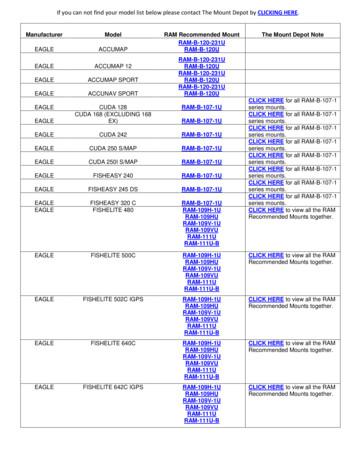ASTR 101 Introduction To Astronomy: Stars & Galaxies
ASTR 101Introduction toAstronomy:Stars & GalaxiesProf. Rosalba PernaTA: Cameron /ast101.htmlMAKE SURE TO GO OVER THE SYLLABUS (if you haven’t already done so)ANDCHECK THE TIMETABLE after each class for the READING ASSIGNMENT
Goals of the day Order of MagnitudeAstronomy– Reasonable estimates Size Scales- getting used to astronomy Light year– Measuring distances inastronomy
ClickersGRADED clicker questions will start NEXT WEEK.Remember to bring your clicker to class always.
Order of MagnitudeAstronomy Astronomy frequently deals with very BIGnumbers When dealing with really big quantities, thesmall details become trivial– For example, when we say that the nearest galaxyis 2 million (2,000,000) light-years away, does itreally matter if its actually 2,000,001? 2,000,100?– How far is it to drive from here to Los Angeles?(centimeters won’t matter )What’s a factor of π between friends?
More on order of magnitudeAstronomyHow many piano tuners arethere in Boulder County?A.B.C.D.E.2202002000Too many to count!
Start with known facts andreasonable guessesPopulation of Boulder County?– 300,000 people How many people have a piano?– 1 in 30? Could be off but probably not by much! How many pianos?– 10,000 pianos in Boulder County How often do you need to tune a piano?– Once a year?10,000 piano tunings/year
Other needed estimates How long does it take to tune a piano?– 3-4 hours? 2 tunings per day500 piano tunings2 piano tunings 5 days 50 weeksyearxx tunerdayweekyear piano tunings10,000year 20 tunerspiano tuningsyear500tuner
EarthScales in the Universe:our Cosmic AddressSun/SolarSystemMilky WayGalaxyLocal GroupLocalSupercluster
Scale models of the Universe Scale Sun as a grapefruit (1:10,000,000,000)
What about distances from theSun on the same scale? Earth tip of ball pointpen, 15 meters (49 feet)– Moon 4 cm away fromearth Mars tip of ball pointpen, 23 meters (75 feet) Jupiter marble, 78meters (255 feet)
Moving out of the solar system On this scale, the nearest stars wouldbe a system formed by a cantaloupe, asmall apple and a kiwi fruit, located inthe middle of Alaska (with solar systemin middle of Colorado) There is essentially nothing in between!!
New Scale for the Galaxy: Stars are microscopic - located a few mm apart Milky Way galaxy is 100 meters in diameter,contains 100,000,000,000’s (100’s of billions) ofstars1 to 10 19 scale - MW 100 m3000 yr to counts all the stars in the MW, one per secondSolar system: dot 20 meters away from center
Yet Another Scale for EverythingElseGalaxies are 10” paperplates Milky Way and nearestneighbor Andromeda)are 5 meters apart Galaxy groups andclusters contain 10’s to1000’s of galaxies
Superclusters 50meters across (sizeof buildings in ourscale model) arethe largeststructures we see Observableuniverse is aboutsize of our countyon this scaleIn this image, each dot is an entiregalaxy
Sample Clicker QuestionWhich of these are the mostlikely?A.B.C.D.Two planets collidingTwo stars collidingTwo galaxies collidingNone of the above there’s too much space!
Sample Clicker QuestionWhich of these are the mostlikely?A.B.C.D.Two planets collidingTwo stars collidingTwo galaxies collidingNone of the above there’s too much space!
Milky way and Andromeda Galaxy in local grouppredicted to collide in about 4 billions years
Measuring cosmic distances Most useful measure is based on the speedof light 300,000 km/sec– Light-year the distance light travels in a year 10 trillion kilometers 1016 m Like saying “I live 30 min from Stony Brook” Constant speed for light traveling in space Nothing travels faster through space
Measuring Distances with Light: Earth-Moon 1.5 light-seconds Earth-Sun (a.k.a. astronomical unit, or AU) 8 light-minutes Solar system light-hours
Nearest stars several light-years Milky Way 100,000 light-years 105 ly– Galactic Center is 28,000 light-years away Local group several million light-years 106 ly Observable universe 14 billion light-years 1.4 x 1010ly
Sample Clicker Question A radio message from outer spacearrived today which was sent from planetBuff on the day you were born. Thefriendly aliens sending you the birthdaymessage live:A.B.C.D.In the Solar SystemFrom a close-by star in the Milky WayIn Andromeda, the nearest major galaxyIn a galaxy outside the local group
Answer B: You are probably between 10 and 90years old. Objects at distances between10 and 90 light-years away from us arerelatively close-by stars in the MilkyWay. The solar system is light-hours in size The Local group is millions of light-yearsin size
Over astronomical distances, even lighttakes a lot of time (from a human’sperspective!) to travel between the starsThis means that what we SEE in the distantuniverse is light that has traveled a longtime.Our image of the universe is a delayedimage.In looking out into space, we are lookingback in time!
Look Back TimeWhat we SEE is always delayed by the speed oflight. In the classroom, our view of each other isonly about 10-5 seconds old, so we barely notice(10-5 sec 0.00001 sec)Satellite communications - noticeable delaysThe image of the Sun is old?Analogy: what we “hear” is delayed by the speed of sound - more familiar inour everyday lives (e.g. lightening-thunder delay)
Image of the Orion nebula, 1500 ly away
When studying the Universe, it isimpossible to separate space and time The image of agalaxy spreadsacross 100,000years of time Try to think of whatwe SEE NOW asdifferent from whatmay EXIST now
Sample Clicker QuestionLast night we saw a bright supernova explode inthe Andromeda galaxy (the other big galaxy inthe local group). The remnants from suchexplosions disperse in about 10,000 years.A. The supernova remnant still exists now, andwe will watch it disperse over the next 10,000Earth years.B. In reality, the supernova remnant has alreadydispersed, but we will watch it disperse overthe next 10,000 Earth years.C. The image of the supernova dispersing will notreach us for another 2 million years.D. We will never see the supernova remnantbecause it has already dispersed.
Answer: B This galaxy is millions of light-years awayfrom us. The light left the galaxy millions ofyears ago and only arrived yesterday. Inthe intervening time, the supernovaremnant has dispersed and no longerexists today.But the light that left on the day after theexplosion will arrive here today and wecan see that.
Discussed so far Cosmic Distances Light-Year vs Year Look Back TimeMake sure to become familiar with these concepts!
For next class meeting, reading. .remains on the entire Ch. 1IF you have problems, please let us know!
Astronomy Astronomy frequently deals with very BIG numbers When dealing with really big quantities, the small details become trivial – For example, when we say that the nearest galaxy is 2 million (2,000,000) light-years away, do
ASTRONOMY 101.004 INTRODUCTION TO ASTRONOMY PROFESSOR PATRICIA HENNING FALL 2014 Welcome to a unique astronomy experience! ASTR 101.004 is unique because it is held in the Domed Theater of the New Mexico Museum of Natural History and Science, which contains the highest technology proj
ASTR 101: Introduction to Astronomy The Solar System Prof
ASTR 101 Astronomy: The Solar System ASTRO 120 4 ASTR 102 Astronomy: Stars and Galaxies ASTRO 150 4 AUTO 100-299 By Title CAREER/TECH BE 100-299 By Title CAREER/TECH: . CS 101 Introduc
Verkehrszeichen in Deutschland 05 101 Gefahrstelle 101-10* Flugbetrieb 101-11* Fußgängerüberweg 101-12* Viehtrieb, Tiere 101-15* Steinschlag 101-51* Schnee- oder Eisglätte 101-52* Splitt, Schotter 101-53* Ufer 101-54* Unzureichendes Lichtraumprofil 101-55* Bewegliche Brücke 102 Kreuzung oder Einmündung mit Vorfahrt von rechts 103 Kurve (rechts) 105 Doppelkurve (zunächst rechts)
FISHFINDER 340C : RAM-101-G2U RAM-B-101-G2U . RAM-101-G2U most popular. Manufacturer Model RAM Recommended Mount The Mount Depot Note . GARMIN FISHFINDER 400C . RAM-101-G2U RAM-B-101-G2U . RAM-101-G2U most popular. GARMIN FISHFINDER 80 . RAM-101-G2U RAM-B-101-G2U . RAM-101-
UOB Plaza 1 Victoria Theatre and Victoria Concert Hall Jewel @ Buangkok . Floral Spring @ Yishun Golden Carnation Hedges Park One Balmoral 100 100 100 100 100 100 100 100 100 100 100 100 100 100 100 101 101 101 101 101 101 101 101 101. BCA GREEN MARK AWARD FOR BUILDINGS Punggol Parcvista . Mr Russell Cole aruP singaPorE PtE ltd Mr Tay Leng .
Astronomy 101 – Exploring the . Office hours: Tuesdays from 1 – 2 pm in Elliot 412 Required materials Astronomy Today by Chaisson & McMillan, 8th edition or older (online component is not required) Astro 101 Lab Manual . Jan 5 Introduction Jan 6 The view from here 1.3, 1.4 Jan 8 So
Created and organised by The Interface Mechanical Civil ‘Thou’ (μm) 1/16 (mm) EN 13001-02 Regular, Variable, & Occasional Loads























